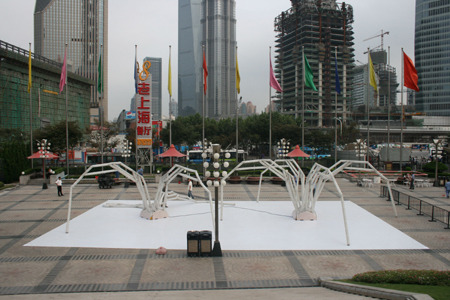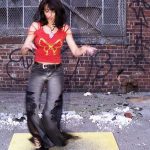An Interview with Chico MacMurtrie by Suzan Sherman
Chico MacMurtie’s Red Hook studio, otherwise known as Amorphic Robot Works, was formerly a church used by Norwegian sailors at the turn of the century, when this section of South Brooklyn was a vital fishing industry. Filled now with plywood boxes, plastic coils, various machines, works in progress, and the remnants of his previous projects, MacMurtries’ studio initially appears to be the messy, albeit inspired, interior of a garage monkey. Since founding Amorphic Robot Works in 1992, MacMurtrie has collaborated with over 20 artists and scientists in making over 100 robots to populate his elaborate performances and interactive environments. Most recently his work has shifted away from literal robotic depictions for which he became known into more abstract sculptures which when inflated with air directly interact with humans. While giving me a tour of the space he showed me the makings of Inflatable Architectural Growth, comprised of various plastic tubes suggesting intestines, which he was prepping to be shown at the San Francisco Art Fair.
SS: Your work is incredibly complex and oftentimes rides the line between art-making and scientific invention. One of the larger questions I had is how you work with engineers and scientists to bring your projects to fruition. Were you guided, for example, toward the materials you’re using for your interactive sculpture, Inflatable Architectural Growth?
CM: Someone directed me to a company that manufactures parachutes. But I often find myself looking online for ideas, or else I seek out experts or I’ll have a discussion with an engineer or someone I know and then try to find a direction with the information I have gathered. I knew that I needed a nonstretchy, high-tensile material. This is spectra [shows me a thick, white plastic-y string]. It has such incredible strength and is super slick and hardly stretches.
Early on and for many years I was making inflatables out of cheap plastic. And then I started making totems for theTotem Pole Forest and those were all made out of ripstop nylon covered in rubber with cast-rubber components stuck on top of them. But 20 years of building robotic sculptures had fallen short of what I was after, which was movement that was more human, or organic—the quality of being really alive. Most conventional robotics always appear so stiff. So I began to pursue the notion of creating both the muscle and bone out of soft materials that could become extremely rigid by filling it with air—that was seven years ago. Then it was no longer necessary to coat the fabric in rubber, and the next step was actually revealing the fabric, and revealing the integrity of the fabric. So the next inflatables stayed white mainly because they were purely about form, and I actually liked the white. I never really thought about color. But three nights ago, I did a press conference at Eyebeam for ZERO01 and there happened to be a red light set up and we ran the inflatable and they really began to look like intestines. It was just a pile of fabric, and then it grew into this 30-foot thing. It looked like a foal being born; it had this interesting quality.
Would you like me to give you a tour of the space?
SS: Yes, I’d love to get a better sense of it. [MacMurtrie leads me into the kitchen.]
CM: This is one of the more favorite rooms; lots of daylight. I love to cook. We cook meals when there’s a big crew here. It’s a nice kitchen. [He leads me into the main space.]
This is the shop, where we build and weld. That’s Franz over there. This is Suzan. This is the tool room—this is like stuff central, all raw material. It seems like a major new tool comes with a grant or with a show and that’s how I end up accumulating them. Some of these tools are really old to begin with, and I’ve also had them for many years. This one’s from San Francisco. Between these old machines you can make so many things. Franz is making a bunch of hinging systems for the machine there. He’s producing them in multiples. He made a prototype, got it working, and now is using that as a pattern for everything else. Here’s more stuff. This is a big, important machine for doing all kinds of things, from just putting holes in aluminum to making things that look as nice as that, to making special shafts and stuff. The lathes and the mill are two really important tools for making things that move. What’s nice is you can close that door and actually heat this in winter, otherwise it’s pretty brutal.
This is a vacuum former. I made it, actually. We use it for making certain parts for inflatables. It allows you to heat up plastic and pull the plastic onto a form. You can make really lightweight components with it.

SS: And how do you figure out how to make something like that without completely blowing up this church? [We’re climbing up makeshift stairs to the church’s second floor.]
CM: Well, it starts out with a need. You start researching it, figuring out what it is, and that’s sort of the way it goes. There’s a whole bunch of other stuff up here. This is mainly storage of older archives. A lot of the pieces I’ve actually made in Red Hook are stored here, including Floating Tree. The Rope Climber goes back several years—that guy’s like fifteen years old. That’s the way the machines were made before, with metal skeletons and actuators. I want to show you the inflatables, and then I’d like to bring you into the living room and show you drawings. This is the inflatables room. That’s Gavino. We’ve determined a bunch of repairs that are needed and he’s preparing all of the parts to be reglued. Part of what we do in order to see that is we use this inflation station.
[MacMurtrie turns on a machine that begins blowing up one of the inflatables and a loud, hissing sound fills the space.]
If you touch it, you get a sense of how hot and rigid it is. Each of these is made up of four vessels,four separate chambers, and each of these chambers will have a sensor on it. The sensor basically tells the computer how much pressure is in it. If the pressure is lower, then the computer tells the valves to give it more pressure. It has a way of learning how stable it is.
It’s a little smelly here from the glue we use, but let me give you a quick tour. Here’s a drawing of what we want to do next, a growing tower that actually ends up able to curve down into an arch. So it starts out growing really tall and then you can send it in four different directions so it can bend or form S curves. Part of it is trying to find the elegance of the form of the human body, but in these abstract, organic geometric forms to bring out qualities of human movement, but it’s not necessarily a human form. I started out wanting to get back to the human form and instead the work ended up getting really big and more architectural. Come on in here. [Chico brings me into the living room with a couch where we sit down.]
SS: So when you’re conceiving of these more recent pieces, are you initially thinking of them as abstract, and then when they’re complete or near completion, you realize, oh, this is a tree? Because it seems that you’re moving more and more away from literal depictions of the bodies that you made in the past, but then when you speak about these pieces you speak about them as if they are potentially non-abstract.
CM: There’s three things going on. You’re technically trying to solve something, you’re sculpturally trying to solve something, and then you’re conceptually trying to solve something. What happens more often than not, all artists are inventing, you’re figuring out how to solve something that hasn’t been done before or that you personally have not done before. You have to find a unique approach to it. This had to get really geometric before it could get built, so it ended up being drawn up in Solid Works( computer-aided design software). All the connections had to be figured out mathematically. All the holes had to be drilled in those balls at the right angle. So the whole thing had to be built, it had to be perfectly simulated in miniature or in a CAD drawing. My process was trying to find it in the materials and in the drawings. I’ve really been talking about these things as abstract forms, but inflatable architectural structures have a dual state, an organic state and a natural geometric shape. So, often I like to talk about them as a molecular look at the structure of your body or the structure of a living thing. Those are the things I’m interested in. But when I made this drawing I thought, wait, this can also be something else. They don’t necessarily have to be a definitive structure, but they create associations by the nature of how they come to life. People see different things and maybe that’s one of the most intriguing aspects of it.
SS: The movement is what reminds them of something that’s literal.
CM: Yes, so as they see this thing move, and although it remains a geometric form, it reminds them of all these things en route to getting to its final state. This is one of my favorite drawings to show people. There are just endless ways of looking at this stuff. Basically I’m trying to innovate the way these things go together. So as a result, there’s a lot of studying how the mechanics of these machines work and try to invent the tools and techniques for doing it. I want to show you some of my sketchbooks.
[Chico lays a selection of small notebooks on a coffee table and we leaf through them together.]
SS: Your drawings make me think of Leonardo DaVinci’s renderings of flying machines and the human body; they remind me of what you just said—that artists are inventors, and that some artists are more inventive than others.
CM: Drawing is such a great tool for artist and it’s a lost tool to a large degree. When I talk to students, I tell them that when you learn how to draw it gives you an advantage over all these other mediums. It’s a language that you can own. People are always trying to talk me into learning how to use computer-aided design. I can always find people to help me with that, but, drawing gives me an instant portable tool directly connected to my way of thinking.
SS: On your website I was reading about your interest in teaching, particularly to children in the Bronx.
CM: When I was living in San Francisco I did these robot-building workshops for children in science contexts, and I did a lot stuff with really underprivileged children as well as very privileged children, but I haven’t done it in the Bronx yet. Here, I did a series of workshops at the Museum of Natural History. It’s similar to the way I approach teaching robot-building to the students I’m teaching right now at Parsons. I’m interested in beginning with the fact that each and every child has an idea of what a robot is. And often it’s not what a robot is on television or cinema. If you really get it out of them, it’s what they are at their time in life and experience. Because “robot” is just a key word. If you set it up correctly, it’s just to get them to imagine something really special. And at the end the robot is them or a friend, or most importantly it represents a state that they are in in their lives. These kids are in a purer state to create, whereas if you tried to do this sort of thing with a teenager or somebody already in their twenties or thirties, it’s more difficult to get them to open up or take chances.
SS: So you were going to show me the video from the other night at Eyebeam.
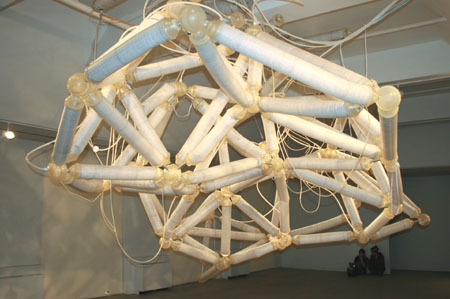
CM: Yeah. [Video runs.] As this work has evolved it’s become more about the duality. What I mean by that en route to becoming the form that I sculpted, it has many other states and qualities along the way, this is the amazing part of the process, when we get this unpredictable thing to happen. What’s happening now is it’s expanding and growing. What the robotic aspect does is it allows the process to repeat in a controlled way. And the light hits it and it becomes…
SS: Pinkish. It has an intestinal quality.
CM: In a way it’s nice because you don’t see the geometry. But this is still in an organic state, and now it’s starting [the structure is inflating] to have a structure and form. That’s what I was trying to do, to get a repetition going, but it’s a challenge to make a machine do something organic over and over again.
SS: So what was this event?
CM: ZERO01 was doing a press event for the festival in San Jose. And Natalie Jeremijenko and Packard Jennings…four groups presented their work.
SS: So Inflatable Architectural Growth is not an interactive piece the way Sixteen Birdsis…?
CM: It is, actually. For each archway there is a sensor. I like to break down so-called interactive work in the simplest of means. Because each of these arches has a learned behavior, something that it can do. Its action on the most basic level is that they draw back into the base and then they go back out and form an arch.The objective was, really, to keep them from falling into the audience area. So if every one of those can do that, and there’s a sensor on each wall, when you walk into the area, and if it’s in one state or the other, you’ll just affect the change, it’ll make it do something different. In that way it’s interactive. But if a person walks over here and stands in front of this for a few seconds, this would raise up.
SS: So it senses the movement of others, but how does it know how to be affected by that movement?
CM: Several sequences for their movement are created and stored. When you set up sensors the goal is to have the sensor trigger one of these stored sequences for a period of time before it’s interrupted and changed by additional interaction. So the sensor can just count people and go, oh, that’s more than four, so do this. So you have a series of things you can do. If you keep it simple it still looks complex. That’s the secret. The most successful interactive artworks for me keep the focus on strong sculptural components and keep the interactive component simple.
For Sixteen Birds, I used a sensor that could detect a human presence (heat). The origin of the project was the Murray River, in Adalaid, Australiaand how all the wildlife in it was dying because that river was shrinking. What I decided to do with Sixteen Birdswas give people the opportunity to come up to it and experienced this “natural phenomenon” from afar, but if you walked too close to the birds, they began exhibiting a nervous behavior and began hopping, which affected the other birds until all of them eventually died. The human presence is detrimental to nature—the premise was as simple as that. For me this was a much better, and symbolic, way to utilize my use of interaction.
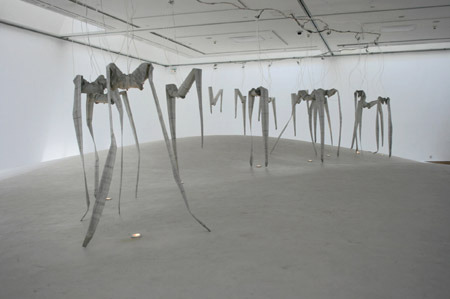
SS: So where does the programming take place within your project? Is it part of the conception of it or does it take place toward the end?
CM: It depends who I’m working with at the time. I’m sort of the mother, I birth the thing, and then these programmers, whoever they might be, end up being the teachers. I’ve always sort of looked at it that way. Sixteen Birds had two different programmers. Initially we made the birds really interactive, and then we taught them how to detect people’s presence in close proximity, but they ended up being off too much of the time, and gallery viewers were like, they’re not working. They were working, but just not as fast as viewers expected them to. In an exhibition format, people only give so many moments, on average, to view an art experience. Some people will hang out longer.Marina Abramovic’s retrospective at MoMA is really important because she’s pushing that by literally showing a live performance in a museum. But my piece is interactive in a purely mechanical sense.
SS: For Floating Tree [a site-specific installation of an aluminum tree and supporting island platform that floated on the East River] did the birds you anticipated actually come to live in your man-made environment?
CM: No, not necessarily, or at least we don’t have any evidence, like feathers or bird droppings. We don’t know if they moved in, but there were ducks hanging out around it. The problem was that we didn’t ask permission to do the project, so it was much shorter lived than we wanted. We just did it, and then they made us pull it out of the river or we’d get a fine. So, unfortunately, we didn’t really get to ever play it out. It’s waiting for an opportunity to do that.
SS: How long was Floating Tree in the water?
CM: Not more than a month, really. It was interesting when we moved it because it got a little away from us because the tide was so strong. Finally the NYPD rescued us. That was a cool story in itself.
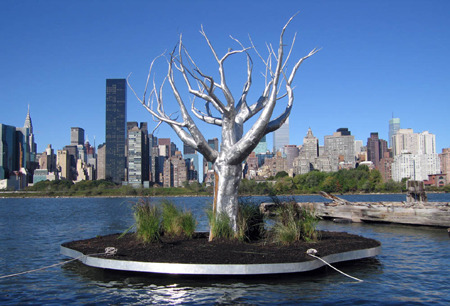
SS: What sorts of things did you draw as a kid, because in the 1960s robotics and the outer space craze was booming. Kids were into drawing robots and watching TV shows like Lost in Space and I wonder if any of that rubbed off on you.
CM: I saw all that stuff, but what’s funny about that was I never drew robots and I wasn’t even necessarily mechanically inclined, but now I’m in shows called “Robots” and “Machines and Souls.” More than thinking about robots, I would fantasize about things. We grew up really poor, and I didn’t really have that much. I had clay, pencil, paper, sticks, and rocks, but with those simple things my imagination was able to take off. I remember making a film when I was a very young, a 16-mm film; I made magical things happen with film. And I would sculpt with clay. I was a performer. In school I realized that I could fuse my interest in performance, film, and sculpture. Puppets were first, then film, and then robotics was a way to automate my ideas. But it wasn’t about robots at all. It was about movement. And my body’s relation to movement in relation to the sculptures. In fact, in undergraduate school I was painting and my minor was in dance. And late one night in the studio, I was painting a figure on canvas, and I was thinking that it was really limited. I kept thinking that building up more paint would transcend the square format, then I just decided to make a physical impression, and I took off my clothes and literally leapt into the painting. And I splattered into the painting and I walked back and looked at it. A physical impression remained on it, which was much more interesting. I was sitting there contemplating it at three in the morning; no one else was in the studio. I walked into the bathroom to peel off the paint, and I look at my reflection in the mirror, and the effect of the paint on my body was much more interesting. And my path to the bathroom was important, too, because my body was restricted from the dried paint, it made it difficult to move. And then finally, peeling the skin of paint off and revealing myself under this sort of horrid depiction was even more important. That night was such crucial moment for me, because I then went on to cast my body, paint into molds, and make paint costumes that I performed in for years. And finally, those paint costumes became puppets that were not only animated in performance, but were characters in my films. Eventually I started developing mechanisms to make them move because I was wearing them on my body as extensions; I made them move and that eventually became the machines.
Sometimes I get these questions from young students and thesis students: “Are robots going to take over the world?” “Are computers going to be able to take over our thinking?” To me it’s more about how technology is taking over our lives and controlling our lives, and that everything in our world will be more and more controlled by technology. But in our lifetime, or in the next generation, there’s not going to be a machine that can reproduceall aspects of a human—that’s what I tell them. Why would we want a machine that does that?
Chico MacMurtrie is internationally recognized for his large-scale, performative, robotic installations, and interactive public sculpture. Most recently he has been working on innovative, inflatable sculptures that have been exhibited internationally at Reina Sofia Museum, Madrid (2008); the National Art Museum of China, Bejing (2008); Wood Street Galleries, Pittsburgh (2009); and Museo Universitario de Arte Contemporáneo (MUAC), Mexico City (2009).

